Focus
First-anniversary highlights
October 2007 marked the first anniversary of the launch of Nature Nanotechnology. To mark this occasion the editors collected some highlights from the first 12 issues of the journal. The selection reflects the diversity of nanoscience and technology, and includes contributions from chemists, physicists, material scientists, engineers, biomedical researchers and others. We hope that you enjoy it.
October 2006
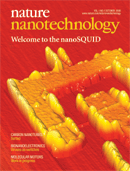
Article:
Carbon nanotube superconducting quantum interference device
J.-P. Cleuziou, W. Wernsdorfer, V. Bouchiat, T. Ondarçuhu & M. Monthioux
Researchers have built the first nanoSQUID — a superconducting quantum interference device with a carbon nanotube at its heart — and hope to use it to detect changes in the magnetic properties of single molecules and in a range of other experiments.
Article:
Sorting carbon nanotubes by electronic structure using density differentiation
Michael S. Arnold, Alexander A. Green, James F. Hulvat, Samuel I. Stupp & Mark C. Hersam
Chemists have developed a scalable method that can sort carbon nanotubes by diameter and electronic type. After being wrapped in a mixture of surfactants, the different nanotubes can be separated by centrifuging them in a liquid containing a density gradient.
Commentary
How the doors to the nanoworld were opened
Christoph Gerber & Hans Peter Lang
The invention of the scanning tunnelling microscope in 1981, followed by the atomic force microscope five years later, opened the doors to the nanoworld. 25 years later scanning probe microscopes are still at the cutting edge of nanoscience and technology.
Feature
nan'o·tech·nol'o·gy n.
Governments invest billions in it and tens of thousands of papers are published on the subject every year, but what exactly is nanotechnology?
November 2006

Article:
Rare earth nanoparticles prevent retinal degeneration induced by intracellular peroxides
Junping Chen, Swanand Patil, Sudipta Seal & James F. McGinnis
Cerium oxide nanoparticles could be used to treat eye disorders and other diseases according to new research. Experiments on rats show that nanoceria can protect the retina before exposure to damaging levels of illumination, and assist recovery afterwards, by neutralizing the effects of reactive oxygen intermediates.
News & Views by Silva
Commentary:
Who is winning the global nanorace?
Angela Hullmann
Analysis of scientific papers, patent applications and funding, by geography and area of nanotechnology, reveals the different strengths and weaknesses of Europe with respect to the US, Japan and the rest of the world.
News & Views:
Nanoelectronics: Crossing boundaries and borders
Lou-Fé Feiner
Collaborations between academic institutions and industrial companies are increasing across Europe, even though each measures progress on different time scales.
December 2006
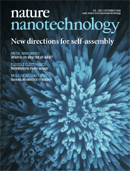
Letter:
Experimental realization of suspended atomic chains composed of different atomic species
J. Bettini, F. Sato, P. Z. Coura, S. O. Dantas, D. S. Galvão & D. Ugarte
What happens to a metal alloy when it is mechanically stretched to form a nanowire that contains just a few atoms? Can a chain of atoms still be an alloy?
Commentary:
What drives public acceptance of nanotechnology?
Steven C. Currall, Eden B. King, Neal Lane, Juan Madera & Stacey Turner
The first large-scale empirical study of how consumers view the risks and benefits of nanotechnology shows that nano-based products are viewed as relatively neutral, and as less risky and more beneficial than GMO.
January 2007
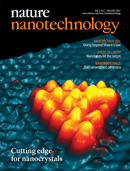
Letter:
In vivo biodistribution and highly efficient tumour targeting of carbon nanotubes in mice
Zhuang Liu, Weibo Cai, Lina He, Nozomi Nakayama, Kai Chen, Xiaoming Sun, Xiaoyuan Chen & Hongjie Dai
Single-walled carbon nanotubes decorated with a water-soluble polymer and a peptide are highly efficient at targeting cancer tumours in mice.
Thesis:
The man who understood the Feynman machine
Chris Toumey
Everyone has heard of Feynman, Binnig and Rohrer, and the scanning tunnelling microscope, but where does Conrad Schneiker fit in?
February 2007
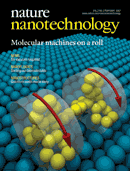
Article:
Ultra-sensitive NEMS-based cantilevers for sensing, scanned probe and very high-frequency applications
Mo Li, H. X. Tang & M. L. Roukes
A nanomechanical device that contains a self-sensing nanocantilever has demonstrated an unprecedented mass resolution of less than 1 attogram at room temperature under ambient conditions.
News & Views:
Organic electronics: Self-assembly is ready to roll
Walter F. Smith
In the effort to make better and less expensive optoelectronics devices molecular self-assembly proves to be a solution — in solution.
March 2007
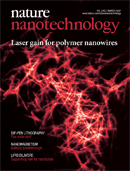
Review article:
Applications of dip-pen nanolithography
Khalid Salaita, Yuhuang Wang & Chad A. Mirkin
Dip-pen nanolithography is widely used for many applications including the templated assembly of materials and the patterning of biological nanoarrays — and new developments and variations of the technique could further extend its capabilities.
Top down bottom up:
Chalk and talk
Denmark launches a major multidisciplinary project to apply nanotechnology in the oil industry.
April 2007
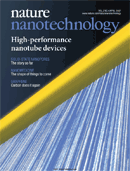
Article:
High-performance electronics using dense, perfectly aligned arrays of single-walled carbon nanotubes
Seong Jun Kang, Coskun Kocabas, Taner Ozel, Moonsub Shim, Ninad Pimparkar, Muhammad A. Alam, Slava V. Rotkin & John A. Rogers
Researchers have built devices containing thousands of single-walled carbon nanotubes that demonstrate excellent mobility and other performance characteristics, as well as good device-to-device uniformity.
Review article:
Solid-state nanopores
Cees Dekker
By monitoring forces and ion currents as molecules pass through nanosized pores in insulating membranes, it is possible to investigate a wide range of phenomena involving DNA, RNA and proteins.
May 2007
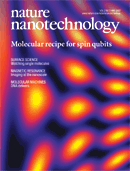
Article:
Nuclear magnetic resonance imaging with 90-nm resolution
H. J. Mamin, M. Poggio, C. L. Degen & D. Rugar
A new approach to magnetic resonance force microscopy has demonstrated a resolution of 90 nm in a two-dimensional image by employing high-moment magnetic tips and a new measurement protocol.
Review article:
DNA nanomachines
Jonathan Bath & Andrew J. Turberfield
The ability to make DNA strands with arbitrary base sequences allows researchers to self-assemble designer nanomachines and motors, and the well-established biochemistry of DNA can be used to control the operation of these devices.
June 2007
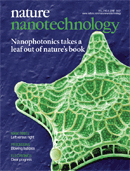
Letter:
Optically active single-walled carbon nanotubes
Xiaobin Peng, Naoki Komatsu, Sumanta Bhattacharya, Takanori Shimawaki, Shuji Aonuma, Takahide Kimura & Atsuhiro Osuka
Following in the footsteps of Pasteur, researchers in Japan have used chemical 'nano-tweezers' to separate mirror-image carbon nanotubes by selectively plucking either left- or right-handed forms from a mixture of the two.
News & Views:
Nanostructures: Drip painting on a hot canvas
Colin Bain
When droplets of water containing metal particles are deposited on a hot surface, they are supported by a thin layer of vapour that lets them slide, essentially friction free. The metal trails the droplets leave in their wake could be useful for making nanowires.
July 2007
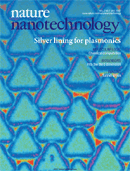
Letter:
Imaging the dynamic behaviour of individual retinal chromophores confined inside carbon nanotubes
Zheng Liu, Kazuhiro Yanagi, Kazu Suenaga, Hiromichi Kataura & Sumio Iijima
Vision is triggered when retinal molecules in the eye absorb light and change shape. By trapping these molecules inside carbon nanotubes, researchers have been able to image these changes with high-resolution TEM, allowing us to see how we see.
Editorial:
Future challenges for Asia
The scientific output of the Asia�Pacific region is growing, especially in nanoscience and technology, but there is scope for greater collaboration and networking between researchers.
August 2007
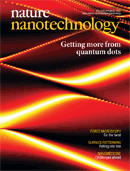
Article:
Assembly of aligned linear metallic patterns on silicon
Jinan Chai, Dong Wang, Xiangning Fan & Jillian M. Buriak
Metallic nanowires can be patterned on silicon surfaces by loading acid-responsive block–copolymer templates with metal ions and briefly subjecting them to an oxygen plasma treatment.
Review article:
Immunological properties of engineered nanomaterials
Marina A. Dobrovolskaia & Scott E. McNeil
More than 200 nano-enabled products have entered the pharmaceutical pipelines, yet no formal guidelines have been established to assess the toxicity of these products to the immune system.
September 2007
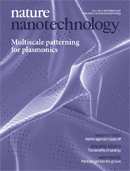
Article:
Nanoparticle printing with single-particle resolution
Tobias Kraus, Laurent Malaquin, Heinz Schmid, Walter Riess, Nicholas D. Spencer & Heiko Wolf
Since the invention of the printing press, methods for stamping 'ink' to replicate words, designs and, more recently, electronic circuits have evolved considerably, and it is now possible to stamp features with 100 nm resolution using gold nanoparticles.
News & Views:
Superconducting devices: Cooling electrons one by one
Silvano De Franceschi & Natalio Mingo
A nanoscale superconducting device in which the flow of heat can be switched on and off by a gate voltage — a heat transistor — has been demonstrated at temperatures close to absolute zero.
